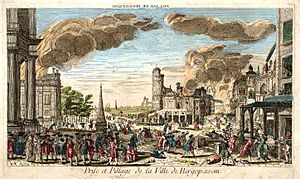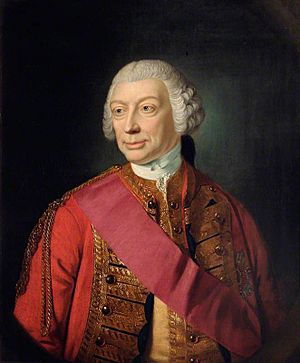Battle of Lauffeld facts for kids
Quick facts for kids Battle of Lauffeld |
|||||||
|---|---|---|---|---|---|---|---|
| Part of War of the Austrian Succession | |||||||
 Louis XV with Maurice de Saxe at Lauffeld |
|||||||
|
|||||||
| Belligerents | |||||||
| Commanders and leaders | |||||||
| Strength | |||||||
| 80,000 up to 200 guns |
82,000 to 98,000 170 guns |
||||||
| Casualties and losses | |||||||
| 6,000(excluding prisoners) to 11,000 casualties 23 guns |
c. 5,000 to 11,000 casualties | ||||||
The Battle of Lauffeld was a major battle fought on July 2, 1747. It took place near Tongeren in modern Belgium, and the Dutch city of Maastricht. This battle was part of a bigger conflict called the War of the Austrian Succession.
In this battle, a French army of about 80,000 soldiers, led by a very skilled general named Marshal Saxe, fought against an Allied army. The Allied army had about 120,000 soldiers and was led by the Duke of Cumberland. The French army won the battle.
Marshal Saxe was one of the best generals of his time. He had already taken control of many areas in the Austrian Netherlands (which is now mostly Belgium) between 1744 and 1746. In 1747, the Duke of Cumberland planned to attack and take back the city of Antwerp. However, the French army threatened his supply routes, forcing him to retreat towards Maastricht.
When the two armies met at Lauffeld, the Duke of Cumberland made some mistakes. These mistakes put his army in a difficult spot. Only brave counterattacks by the Allied cavalry (soldiers on horseback) stopped a much worse defeat. The battle ended the Allies' hopes of winning back the land they had lost. After this, Marshal Saxe captured Bergen op Zoom in September 1747 and Maastricht in May 1748.
However, the war was very expensive for France, and they were running out of money. The Royal Navy (Britain's navy) also stopped French ships from trading, causing food shortages. This problem got worse after the French navy lost a battle at Cape Finisterre in October 1747. This loss meant France could not protect its trading ships. Because both sides were struggling, they eventually agreed to a peace treaty. This treaty was called the Treaty of Aix-la-Chapelle and was signed in October 1748.
Why the Battle Happened
The War of the Austrian Succession
The War of the Austrian Succession started in 1740. It was a big European conflict about who would rule Austria. At first, Britain was busy with another war against Spain in the Caribbean. British and Dutch soldiers in Flanders (a region in Europe) were fighting as part of an army from Hanover (a German state). France did not officially declare war on Britain until March 1744. The Dutch Republic was neutral, meaning they didn't pick a side, until 1747.
French Control and Peace Talks
In October 1746, France won the Battle of Rocoux. This victory gave them control of the Austrian Netherlands. However, it did not make Britain agree to peace. France had joined the war to stop Britain from becoming too powerful in trade. But by 1747, British trade was growing again. Meanwhile, the French economy was suffering because the British navy was blocking their ships.
By the end of 1746, most countries wanted peace. Maria Theresa, who was now the ruler of Austria, wanted to rebuild her army. She hoped to take back Silesia, a region she had lost. Austria had only gained the Austrian Netherlands in 1713 because Britain and the Dutch Republic didn't want each other to control it. So, keeping this area was not Austria's top goal.
Being neutral had allowed the Dutch to carry most of France's goods. Losing this trade hurt both economies. The Dutch government pushed Britain to make peace. Britain was also getting into a lot of debt, but they could handle it better than France.
Allies Keep Fighting
To keep their allies fighting, Britain agreed in January 1747 to pay for Austrian and Savoyard (from Italy) armies. They also agreed to fund an Allied army of 140,000 soldiers in Flanders. This number would increase to 192,000 in 1748. The Duke of Newcastle, who was in charge of Britain's foreign policy, thought the Allies were strong enough to get a better peace deal. He hoped they could take back the Netherlands. He also thought the alliance between France and Spain might break apart. Even though these ideas turned out to be wrong, Newcastle told his envoy, Lord Sandwich, to delay peace talks.
The Battle of Lauffeld
Setting the Stage
Marshal Saxe gathered a large army of 120,000 men for the 1747 campaign. Meanwhile, the Jacobite Rising (a rebellion in Britain) had ended. This allowed the Duke of Cumberland to bring his troops back to Flanders. He planned an attack, hoping to capture Antwerp in February. But bad weather and problems with transport meant the Allies were not ready until early May.
During this delay, French generals captured important forts. This made Antwerp too strong to attack. Also, French forces threatened Cumberland's supply lines to Maastricht. This situation led to a change in leadership in the Dutch Republic. William IV became the first hereditary Stadtholder (a kind of leader) of all seven Dutch provinces.
Preparing for Battle
To protect Maastricht, Cumberland sent von Daun to secure Tongeren. This town was held by French forces. The Allied cavalry, led by Ligonier, was ordered to take control of the road between Tongeren and Maastricht. This road ran along a ridge next to the Meuse river.
However, the French were already there. So, the Allied cavalry stopped for the night. The infantry (foot soldiers) stayed in the villages of Vlytingen and Lauffeld. The Austrian troops were on the right side, holding the villages of Grote and Kleine Spouwen. A steep ravine in front of them protected them from attack. The Dutch army held the center. The left side, around Lauffeld village, had British, Hanoverian, and Hessian troops.
Most reports say about 82,000 French soldiers faced a slightly smaller Allied army. The next day was cloudy, and heavy rain made it hard to move. The battle started with artillery fire at 6:00 am, which lasted until 8:30 am.
Cumberland's Mistake
Cumberland then made a big mistake. He moved his infantry out of the villages where they had spent the night. He even ordered the villages to be set on fire. At the Battle of Fontenoy in 1745, Marshal Saxe had used similar positions to cause heavy losses to the Allied troops. Ligonier urged Cumberland to put the soldiers back in the villages. After some thought, Cumberland agreed. But this change in orders caused confusion among his officers.
Marshal Saxe thought Cumberland was retreating across the Meuse river. Around 10:30 am, he sent his infantry forward to take the villages. Vlytingen was empty, but Lauffeld had been re-occupied by troops led by Frederick of Hesse-Kassel. Over the next few hours, the village changed hands four or five times. The French finally captured it around 12:30 pm.
Cumberland ordered a counter-attack. But as his infantry got ready, a Dutch cavalry unit in front of them was defeated by the French. They ran away, causing chaos among the soldiers behind them. This left the Allied center exposed. The Dutch soldiers in the center had only made two attacks, both of which failed due to French artillery. They lost 537 men. When the Allied left side gave way, the center and right followed.
Ligonier's Brave Charges
Meanwhile, 150 squadrons of French cavalry gathered to attack Cumberland's side. Ligonier, not knowing the Allies were retreating, led 60 squadrons in a charge. They surprised the French cavalry. This was one of the most famous cavalry charges in British military history. Marshal Saxe later said that this charge alone stopped him from completely destroying the Allied army.
The French Irish Brigade suffered more than 1,400 casualties (soldiers killed or wounded). At one point, Cumberland, who had poor eyesight, mistook the red-coated Irish soldiers for his own troops. He barely escaped being captured. To protect the retreating infantry, Ligonier got permission for another charge. This time, he only had three regiments. He was taken prisoner, and one of the units, the Scots Greys, lost almost 40% of their soldiers. This brave action gave time for Karl Josef Batthyány and his Austrian troops to cover the Allied retreat.
After the Battle

Casualties and Consequences
The total number of soldiers killed or wounded in the battle varies. Estimates range from 5,000 to 11,000 on each side. As before, Marshal Saxe could not fully follow up on his victory. Some critics said he was trying to make the war last longer to increase his own fame.
Lauffeld was another French victory that did not end the war. However, it did lead to the capture of Bergen-op-Zoom in September 1747. It also led to the capture of Maastricht in May 1748. The battle also showed again that Cumberland was not a strong general. His weaknesses, like not scouting enough, not understanding the bigger picture, and poor communication, had also caused his defeat at the Battle of Fontenoy in 1745. For example, he failed to tell Ligonier that he had pulled back the infantry.
Financial Troubles and Peace
Even with their success in Flanders, the British naval blockade caused problems for France. French customs income dropped, and they were cut off from the Newfoundland cod fisheries. This was a key food source for many poor people. France's Finance Minister, Machault, warned King Louis XV that their financial system was about to collapse.
France's situation got worse in October 1747. The Royal Navy attacked a large group of French merchant ships going to the West Indies. This happened at the Cape Finisterre. Most of the merchant ships escaped, but the British were warned of their approach. A British squadron then captured many of them in late 1747 and early 1748. After this defeat, the French navy could no longer protect its colonies or trade routes.
In November, Britain and Russia signed an agreement for more troops. In February 1748, 37,000 Russian soldiers arrived in the Rhineland. However, by this time, the Duke of Newcastle was also ready to agree to peace terms. Some argue he did not fully understand how much the naval blockade was hurting the French economy.
The Treaty of Aix-la-Chapelle
The terms of the Treaty of Aix-la-Chapelle were first agreed upon by Britain and France. Then, they were presented to their allies. The treaty confirmed that Prussia would keep Silesia. There were also small changes to land in Italy. But mostly, the situation went back to how it was in 1740. France had to leave the Low Countries. Giving back the land they had fought so hard for, for so little in return, led to the saying "as stupid as the Peace."
The war showed that the Dutch Republic was no longer a major power. Newcastle blamed himself for his "ignorance, obstinacy, and credulity" for thinking otherwise. Britain then looked for a new ally in Europe to replace the Dutch. This led them to accept Prussia's control of Silesia. This decision, in turn, caused the end of the Anglo-Austrian Alliance. It also led to a big change in alliances known as the Diplomatic Revolution.
|


